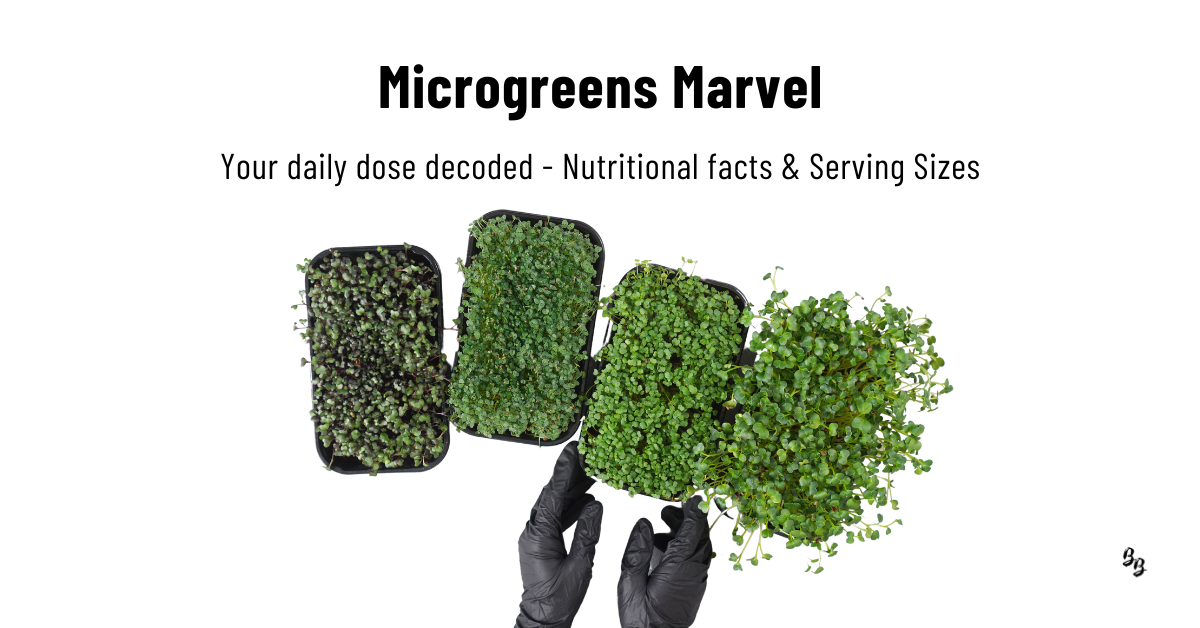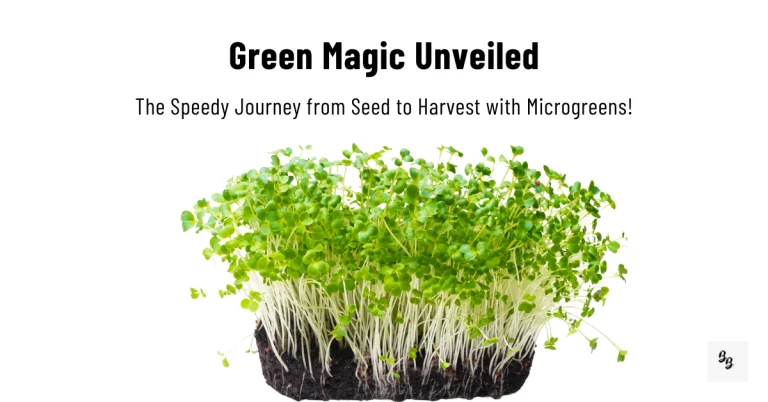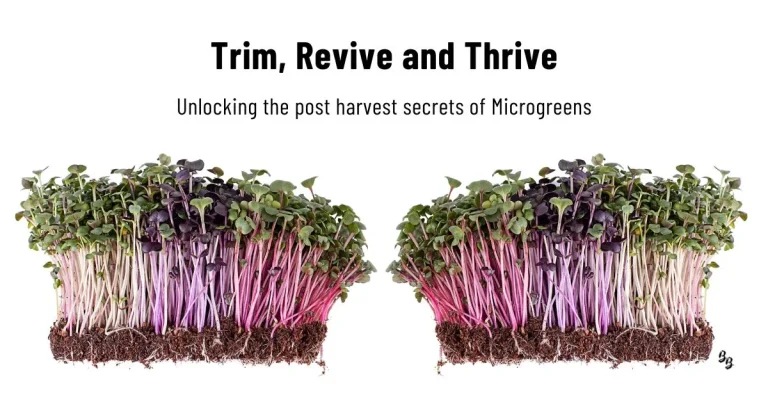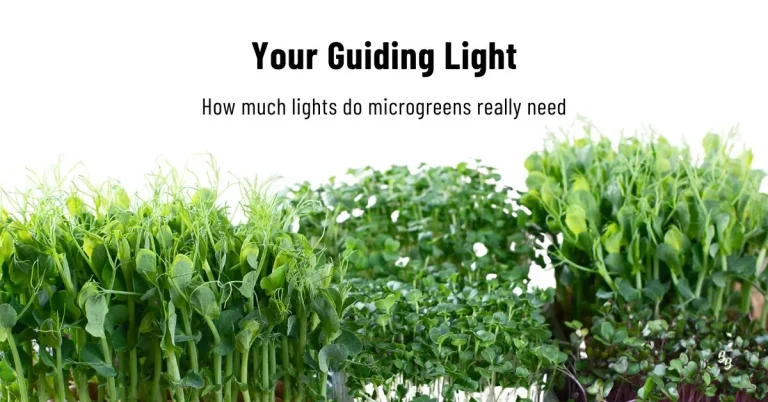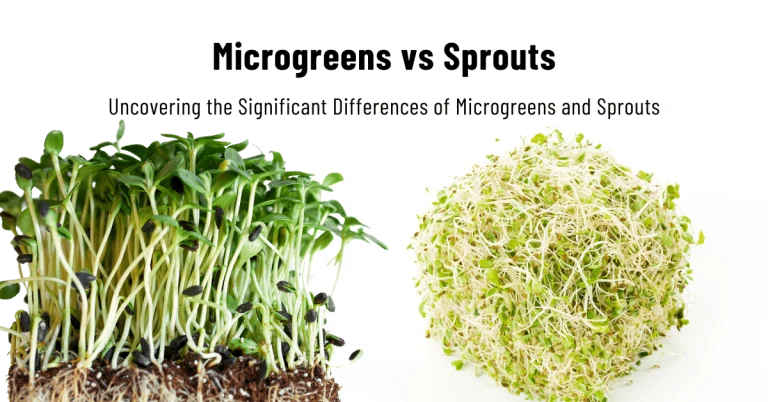How much microgreens to eat per day (Nutrition Information)
Microgreens; a vegetable confetti that is in the forefront of everyone’s mind. With their growing popularity, you may be asking yourself; “How much microgreens should I eat per day?”
It’s fair to assume that if there is a recommended intake of water per day, there should be one for microgreens, right?!
Nutritional value of microgreens
Known to be rich in vitamins and minerals, they are a special addition to your diet. With an abundance in vitamins C, E, and K, which play a vital role in maintaining overall health.
These vitamins contribute to boosting the immune system, supporting healthy skin, promoting blood clotting, and aiding in bone health. Additionally, microgreens contain essential minerals such as potassium, iron, and calcium, which are crucial for various bodily functions, including nerve function, muscle contraction, and bone density.
These young greens are also a fantastic source of antioxidants. Antioxidants help protect the body against oxidative stress and free radicals, which can contribute to chronic diseases and aging.
Studies have shown that microgreens, particularly red cabbage, cilantro, and radish microgreens, contain high levels of antioxidants that can aid in reducing inflammation and preventing cell damage.
Furthermore, dietary fiber, packed in microgreens, benefits digestion and maintains a healthy weight. Fiber helps regulate digestion, promotes satiety, and supports a balanced gut microbiome.
Microgreens also have low calories and fat, providing good protein. This makes them an excellent choice for individuals looking to incorporate nutrient-dense foods into their diet while managing their calorie intake.
Overall, microgreens offer an impressive nutritional profile, providing an array of vitamins, minerals, antioxidants, and fiber. By incorporating these tiny greens into your meals, you can enjoy a nutritious boost that contributes to overall health and well-being.
Daily recommended dietary allowance and Serving sizes
Here’s a breakdown that includes the daily recommended dietary allowances (RDAs) for some of the key nutrients found in the microgreens mentioned:
Radish:
Radish microgreens are a nutritious addition to your diet, offering a significant percentage of the recommended daily intake for essential vitamins and minerals. They provide approximately 20-25% of the RDA for vitamin A, 15-20% for vitamin C, 50-60% for vitamin K, and 10-15% for iron. For adults, the general guideline for vitamin A intake is around 700-900 micrograms for men and 600-700 micrograms for women. The RDA for vitamin C is about 75-90 milligrams for men and 60-75 milligrams for women. For vitamin K, the RDA is approximately 120 micrograms for men and 90 micrograms for women. As for iron, the RDA is about 8-11 milligrams for adult men and 18 milligrams for adult women.
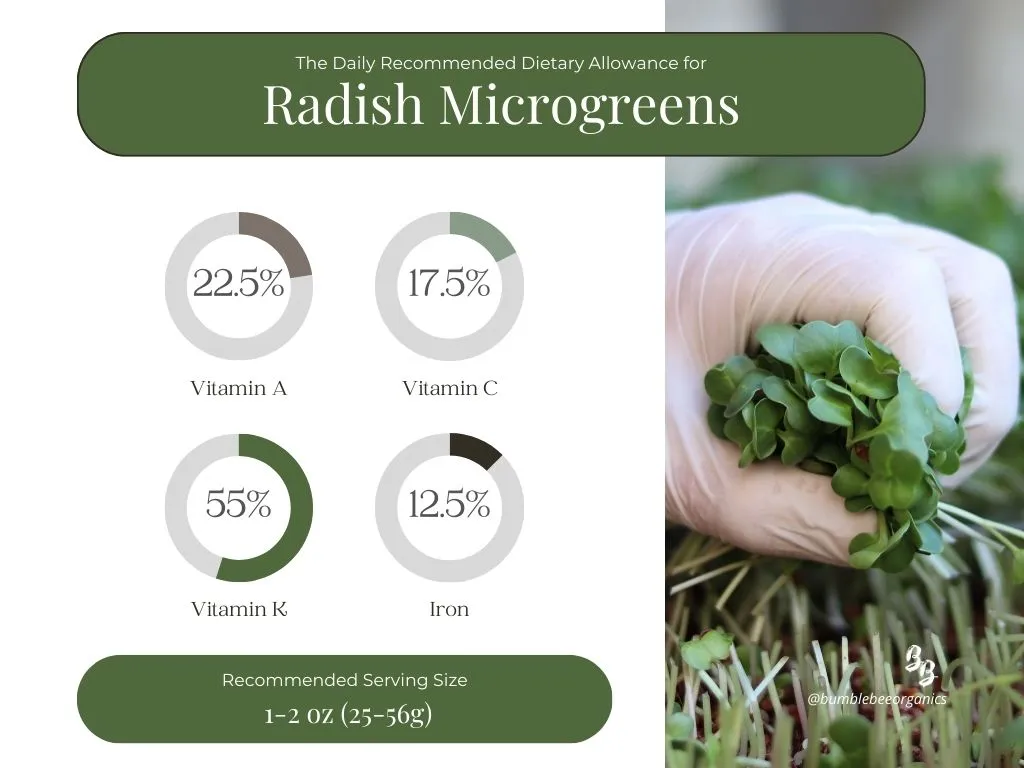
Broccoli:
These nutrient-rich microgreens offer a substantial percentage of the recommended daily intake for various essential vitamins and minerals. They provide approximately 15-20% of the RDA for vitamin A, 50-60% for vitamin C, 80-90% for vitamin K, and 4-6% for calcium. The RDA for vitamin A is around 700-900 micrograms for men and 600-700 micrograms for women. Similarly, the RDA for vitamin C is approximately 75-90 milligrams for men and 60-75 milligrams for women. For vitamin K, the RDA is about 120 micrograms for men and 90 micrograms for women. As for calcium, the RDA is approximately 1000 milligrams for most adults.
Red Cabbage:
These microgreens offer valuable nutrients and contribute to a significant percentage of the recommended daily intake for essential vitamins and minerals. They provide approximately 10-15% of the RDA for vitamin A, 40-50% for vitamin C, 70-80% for vitamin K, and 6-8% for iron. Like radish and broccoli microgreens, the RDA for vitamin A is around 700-900 micrograms for men and 600-700 micrograms for women. The RDA for vitamin C is approximately 75-90 milligrams for men and 60-75 milligrams for women, similar to the values of radish and broccoli microgreens. For vitamin K, the RDA is about 120 micrograms for men and 90 micrograms for women, consistent with the recommendations for radish and broccoli microgreens. As for iron, the RDA is approximately 8-11 milligrams for adult men and 18 milligrams for adult women, which aligns with the values seen in radish microgreens.
Basil:
Basil microgreens, similar to radish, broccoli, and red cabbage microgreens, offer comparable recommended daily intakes for vitamins A, C, and K. They provide approximately 5-10% of the RDA for vitamin A, 10-15% for vitamin C, and 15-20% for vitamin K. However, their calcium content is relatively lower, contributing approximately 2-4% of the RDA. It’s important to note that the RDA for calcium is approximately 1000 milligrams for most adults.
While basil microgreens might not be as rich in calcium, they still provide valuable nutrients and can be a nutritious addition to your diet. To meet your calcium needs, consider incorporating other calcium-rich foods into your meals.
Kale:
Kale microgreens offer 70-80% RDA for vitamins A, C. Rich in vitamin K (300-400% RDA). Provide 8-10% RDA for calcium. Similar to radish, broccoli, and red cabbage microgreens. Boost nutrient intake, promote health with kale microgreens. Meet calcium needs with calcium-rich foods.
Including a typical serving size of 1 – 2oz (25 – 56g) of microgreens in your diet can be a flavorful and nutritious way to support your overall health and well-being.
These are general estimates for the recommended daily allowances (RDAs) of nutrients, and individual nutritional needs may differ based on factors like age, sex, health condition, and specific dietary requirements.
The values presented here are approximate percentages of the average daily requirements for adults. To get accurate and personalized recommendations, it’s crucial to consider individual needs and consult with a healthcare professional or a registered dietitian.
They can provide tailored nutritional guidance based on your unique circumstances and help you meet your specific nutritional goals.
Recommended service size
While there is no standard serving size for microgreens, a typical recommended serving size is around 1 to 2 ounces (28 to 56 grams) by weight.
However, you can adjust the serving size based on your personal preferences and the specific microgreen variety you are consuming. A small serving of They are highly concentrated in nutrients, and can provide significant benefits.
Please remember that these are general recommendations, and you can adjust the serving size based on your taste preferences and specific nutritional needs. Incorporating a variety of microgreens into your meals can add flavor, texture, and nutritional value to your dishes.
What are microgreens?
They are not mature greens or even mature leaves. They grow quickly, and require little water. Known simply as greens harvested after the cotyledon leaves have developed with one set of true leaves.
Microgreens are the plant’s stage between a sprout and a baby green. These young vegetable greens are approximately 1-3 inches (2.5 – 7.5cm) tall. They are harvested 7-21 days from germination, once the plant’s first true leaves appear.
It’s a great addition to any household, boasting with intense flavour, a range of different vitamins and immune boosting properties. Functional food that can easily be grown in the comfort of your kitchen.
To top it off, they offer a tasty way to improve any dish!
In recent years, these little greens have become more popular as people discover their powerful antioxidants and nutrient content.
So, let’s dig into exactly what these recommendations are.
We’ll highlight a few types of microgreens with their health benefits and nutritional value.
Types of microgreens:
There are hundreds of varieties of microgreens that can be grown and consumed. Most of which do not necessarily require a growing medium. They come in a wide variety of flavors, textures, and colors, making them a delightful addition to culinary creations.
The diversity of microgreens that is available each have their own unique characteristics.
For instance, vibrant red Amaranth microgreens add a touch of visual appeal and possess a mild, earthy flavor. Pea shoots, with their delicate tendrils and sweet taste, offer a refreshing crunch to salads and sandwiches. Nutty and slightly spicy, radish microgreens provide a zesty kick to dishes.
Delicate micro Basil leaves bring a burst of aromatic flavor reminiscent of their larger counterparts, while micro Cilantro offers a pungent and citrusy twist. Tender micro Arugula leaves carry a peppery bite, and Sunflower microgreens present a pleasant nuttiness. These are just a few examples of the wide range of available, each offering its unique taste profile and culinary versatility.
Here’s are some of the most popular
Radish
These are small tender greens that possess a distinct pepper flavour. They have vibrant red stems and green leaves that can add a pop of colour to any dish. Rich in antioxidants, vitamins, and minerals. They provide a zesty kick to salads, sandwiches, and wraps, and can also be used as a garnish for various dishes.
The spicy flavor of radish microgreens complements well with creamy dressings, cheeses, and roasted vegetables, offering a delightful balance of flavors.
Broccoli
Broccoli microgreens have a milder taste compared to mature broccoli but still retain a hint of its signature flavor. These microgreens are packed with essential nutrients, including vitamins A, C, and K, as well as dietary fiber.
They have a delicate, crisp texture and are often used as a nutritious addition to salads, stir-fries, and sandwiches. Broccoli microgreens provide a fresh and slightly sweet taste, enhancing the overall flavor profile of dishes while offering the added health benefits associated with broccoli.
Red Cabbage
Red cabbage microgreens exhibit a beautiful purple hue and are known for their crunchy texture and mild, slightly sweet flavor. These microgreens are abundant in vitamins A and C, as well as antioxidants. With their vibrant color, they make for an eye-catching addition to salads, slaws, and wraps.
The tender leaves of red cabbage microgreens can also be used as a garnish or added to sandwiches, providing a pleasant crunch and a subtle sweetness to dishes.
Basil
Basil microgreens showcase the aromatic essence of their mature counterpart but in a more concentrated form. These microgreens possess a robust, fragrant flavor that adds a burst of freshness to dishes.
With their tender leaves and a more intense basil taste, they are a popular choice for garnishing pizzas, pasta dishes, and soups. Basil microgreens can also be used to infuse oils or vinegars, providing a delightful herbal twist to homemade dressings or marinades. Their versatility and strong flavor make them a favorite among herb enthusiasts.
Kale
Kale microgreens are miniature versions of the nutrient-dense leafy green. They offer a milder taste compared to mature kale, with a hint of earthiness and a slightly sweet undertone. These microgreens are an excellent source of vitamins A, C, and K, as well as minerals like calcium and iron.
They can be enjoyed in salads, smoothies, or sandwiches, adding a pleasant crunch and a touch of green goodness. Kale microgreens are versatile and can be incorporated into a wide range of dishes, contributing to both flavor and nutrition.
Buckwheat
Buckwheat microgreens are characterized by their delicate, tender leaves and mild, nutty flavor. These microgreens are not related to wheat and are gluten-free. They are packed with essential nutrients, including fiber, protein, and minerals like manganese and magnesium.
Buckwheat microgreens are commonly used in salads, wraps, and stir-fries, adding a pleasant crunch and a subtle nuttiness to the dishes. With their rich nutritional profile and unique taste, they offer a valuable addition to a healthy and diverse diet.
Pea Shoots:
Pea shoots are the young, tender shoots of the pea plant and are cherished for their sweet and delicate flavor. These microgreens are packed with vitamins A, C, and folic acid, along with fiber and antioxidants.
With their vibrant green color and curly tendrils, pea shoots are often used to enhance the visual appeal of dishes.

They can be enjoyed raw in salads, added to stir-fries, or used as a topping for pizzas and omelets.
Pea shoots provide a refreshing, crunchy texture and a subtle sweetness, making them a versatile and nutritious option for various culinary creations.
Health Benefits of Microgreens
They are not only delicious and visually appealing but also offer numerous health benefits. Despite their small size, these tiny greens are packed with concentrated nutrients, making them a powerhouse of wellness.
Firstly, microgreens are rich in vitamins and minerals. These include vitamins A, C, E, and K, which play essential roles in maintaining overall health.
They also provide a good source of minerals like potassium, iron, and calcium, they can help boost your immune system, support healthy vision, aid in collagen production, and promote strong bones.
Microgreens are also a great source of dietary fiber, which aids in digestion and promotes a healthy gut. They can contribute to weight management by increasing fullness and regulating blood sugar levels.
Moreover, studies have shown that certain microgreens, such as broccoli and radish microgreens, contain high levels of specific phytochemicals that possess anti-cancer properties. These compounds have been found to inhibit the growth of cancer cells and reduce the risk of developing certain types of cancers.
Incorporating a variety of microgreens into your meals not only adds flavor and texture but also provides a plethora of health benefits. Whether you choose to enjoy them in salads, sandwiches, smoothies, or as a garnish, microgreens offer a convenient and nutrient-dense way to support your overall well-being.
In conclusion, these greens enhances a meal with flavor and health benefits. These tiny green offer a good source of vitamins but also pack a powerful antioxidant punch. You can elevate the nutritional value of your meals by adding microgreens to a variety of dishes. Whether addressing specific health issues or simply maintaining overall well-being, microgreens offer a convenient and delicious solution. So, embrace the abundance of microgreens available and explore the vibrant world of these nutrient-packed greens to nourish your body and savor a delightful culinary experience.

